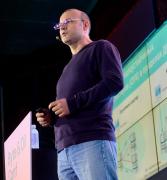Talks
Talks archive
-
 Mikhail Zhilin PostgresPro
Mikhail Zhilin PostgresProUnfortunately, ideal computer systems exist only in science fiction books. PostgreSQL is not exception and sometimes problems may occur. I would like to discuss how to correctly (and incorrectly) try to solve a problem, which way to choose, which tool to use.
The talk is of interest to both beginners and experienced users and database administrators.
-
 Юрий Темкин CyberProtect
Юрий Темкин CyberProtect Ivan Belinsky CyberProtect
Ivan Belinsky CyberProtectAn important aspect of PostgreSQL database security and reliability is backup practices. The talk will reveal the main techniques and methods used to protect data, prevent loss and successfully recover information in case of human error, failures or emergencies. We will tell how CyberBackup helps to protect PostgreSQL, including configuration in Patroni cluster: we will consider system deployment options, important aspects of backup policy configuration, including full and incremental backups. We will also show how to easily work with backups via mount and do granular restores.
-
 Igor Kosenkov PostgresPro
Igor Kosenkov PostgresProOne of the requirements for the operation of the Corosync/Pacemaker failover cluster is the fencing of the failed node. In virtual environments, fencing is implemented by disabling the virtual machine through a hypervisor, in a cluster on physical servers - through IPMI/ILO. But what if it is impossible to organize fencing, for example, in the cloud environment? During this presentation, I will list and explain alternative methods of fencing a failed node.
-
 Vladimir Sitnikov
Vladimir SitnikovA talk on how regular™ indexes work in PostgreSQL. The talk will be extremely useful for those who are starting to work with databases, and for those who have worked with them but have forgotten. If the talk hits the golden picks of "must-see onboarding developer", then the goal is achieved.
We will tackle the following subtopics:
- How an index can speed up search;
- Should we index WHERE conditions;
- Should we index ORDER BY statements;
- Should we index foreign keys;
- What to do if search pre-assumes multiple conditions;
- Which column order should be specified in an index;
- Cases when index causes a slow-down and how to reduce its impact on the app.
Photos
Photo archive